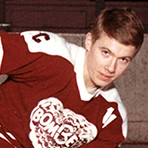Slate
Blackcurrant
Watermelon
Strawberry
Orange
Banana
Apple
Emerald
Chocolate
Marble
Slate
Blackcurrant
Watermelon
Strawberry
Orange
Banana
Apple
Emerald
Chocolate
Marble
-
Content Count
221 -
Joined
-
Last visited
-
Days Won
1 -
Feedback
0%
salibandy last won the day on September 25 2018
salibandy had the most liked content!
Community Reputation
21 GoodProfile Information
-
Spambot control
231564879
Recent Profile Visitors
5902 profile views
-
Hi guys, I wonder if someone would be able to advise on the sizing for the Hzrdus skates, if they'd be similar to the Catalyst. I currently wear an AS-V in 4R which feel bigger than my AS3 in 4 (only got the size 4 as I assumed the stiffness of the 3.5 in Jr sizing would be reduced). Previously wore Easton Mako IIs and other Bauer skates in 3.5D. Any help would be appreciated, thanks!
-
According to Bauer, the Vapor has a more traditional L-shaped eyelet pattern with less material around the foot to allow for more agility, which is one of 6 aspects of the skate designed to differentiate the Vapor as an agility skate. The Supreme has a more sloped cut which wraps the foot better for more stability, and again is one of 6 aspects of the skate meant to designate it as a power skate. The eyelet pattern is designed to work with the eyelet facing to accentuate the attributes of each line.
-
Hey guys, I'm wondering if anyone knows where I can find the skate flex charts for Bauer and CCM skates? I was watching the Bauer webinar on Bauer University and saw they had a skate flex chart for the Supreme line, but can't find it anywhere. Many thanks!
-
I find that taking out the ear covers/protection helps with that. I wear the 710 too and initially had the same problem as you.
-
Most definitely - I think lateral crossovers should be added to a skater's repertoire, I certainly think it's a useful skill. Drais does skate like a prototypical skater from days gone past, and his hands stickhandle a lot less, so I get why people say he looks slow. Realistically though, put anyone beside McJesus on the same line and they'd look slow too haha. On a side note, glad we went 9-2-0 recently after a bit of a slow start. That last performance from 97 was unreal...
-
@YesLanges no, I really don't think I have it mixed up. I agree mostly with what you're saying, yet you seem fixated on a notion that I am talking about maximal strength or force exertion, whereas I have prefaced that the definition of strength is a function of motor control, recruitment and activation. I'll bow out of the discussion now because I don't think my definition will fit with your view, which is fine, but it really isn't going anywhere useful for the OP or anyone who is reading this and wants to improve. Great discussion though! @colins 100% agreed, many differing beliefs which has led to many differing skating styles. I never understood the front-to-back swing that Laura Stamm (and many coaches) taught either because it never made sense from a biomechanical point of view. While front-to-back pumping of the arms made sense for runners whose feet moved in the sagittal plane, skaters' feet moved more in the frontal plane, so the arms should as well. I also don't teach the toe flick that Hall or Eichel does, simply because having a toe flick really extends the cycle of a stride and in the game today, the quick feet and resulting agility seem to be more important. Toe flickers also tend to kick more posteriorly as well, while I teach a more lateral stride (beyond the initial acceleration). The notion of pronation in skating allowing a more powerful stride is correct in my understanding and experience. Coming from a speedskating background, it always made sense because it allows one to dig in better and to push more laterally as well. The increase in mobility as allowed by the loosening of the skating boot (or lowering of the boot cut) also allows skaters to manipulate their edges for increased control. The lowered boot cut was the basis of the Mako skate, if I recall, because more Cruikshank and Van Horne were speedskaters. Jason Yee's videos have great information but are too complicated for the regular skater to figure out I think, which fails to be helpful unfortunately.
-
@Vet88 you're right - I completely read that wrong and thought I saw 'aggro skates with full ankle support'. Totally missed the plot on that one. @clarkiestooth I do teach skating, both Learn-to-Skate and powerskating. Edge control can absolutely come from an ankle control strategy, and some players use it more than others (McDavid with one eyelet down and loose skates). In agility and cutting movements, we speak of ankle, knee and hip strategies - the same can be said for skating, that different skaters utilise different control strategies. Your philosophy of teaching skating is different from mine, that's fine. Although I would find it hard to accept that 'skating has nothing to do with feet/ankles'. I come from a speedskating background with low cut boots and loved the Mako skates, and my philosophy towards skating is probably at the opposite end of the spectrum from yours, which seems to be solely global and not also considering the role of the ankle. @YesLanges I know you were replying to Vet88, but yes I do mostly agree with you. I will say that motor unit recruitment is the activation of contractile units in a muscle, so when the neural adaptations do occur, it is increasing motor unit recruitment to better control the ankle, which ultimately is increasing the strength based on the increased amount of contractile units activated. This is how I understand and interpret how motor learning and muscles work, at least. So yes, edge control changes are related to changes in muscle strength, because strength is a function of motor control, recruitment and activation. I think the bike riding analogy is not the right fit for my example of degrees of freedom, which has nothing to do with weakness. Also, I agree with you that the deterioration of skills over many years isn't solely the function of the strength of the muscles involved. @BenBreeg yes, a lot of semantics involved. I like discussions like this, it makes you think and connect with how others think in their head. I do agree with your experience - when I first tried skating with my laces undone, I had to fix my hip positioning. Ankle control was the last thing I worked on, because without fixing the hips, changing the ankle angles made little difference in my technique. Also, great discussion guys. I wonder though, has @Koopa got what he needed from our combined experience, or is just lost amongst all the discussion haha
-
Yes it does. Would I look to replace the foam that's been abraded from edge of the pad too? Or will just covering it up with nylon be enough, in essence just preventing it from becoming worse?
-
@YesLanges You're not talking about different things from what I am - coordination comes from 2 things, motor control (recruitment) and strength. In the context of the skater, being able to control the ankle muscles comes from motor learning, in the absence of weak muscles. With reference to ankle weakness in relation to skating, it is still weak in that it is not able to be used for its intended purpose. With regards to ankle weakness as to normal standards, that was a comment to the OP that addressed muscular weakness, not coordination. They are different things - the muscles controlling a normal ankle without weakness may have the cross-sectional area to develop neuromuscular strength and motor control for skating, but a weak ankle may not. The comment addresses the latter, while my first paragraph here addresses the former. I don't disagree with you - for anyone without weak ankles by normal standards, a balance disk may serve no purpose, therefore go and skate with one eyelet down, which is what I also mentioned. Don't confuse what I said though. While adding in stickhandling may or may not be an added cognitive task, don't let that aspect distract from the notion of using balance disks for building ankle coordination and strength, and again strictly in the context of a (for lack of better word) truly weak ankle. It's not about learning 2 things at once. Also, you may have missed the point about motor learning. What I am talking about is freezing degrees of movement when learning something new. Meaning one does a movement with the whole body, think a new skater on ice, instead of skating with the objective to learn to control their ankles. This is applicable to the OP because he hasn't skated in soft boots in awhile and mostly skated in aggro skates (basically ski boots), therefore he shouldn't skate with laces untied or even loose at the moment. This is exactly as you said in your last paragraph.
-
As a physio and strength and conditioning coach, I will say there is such a thing as a weak ankle (weak joint). For example, the inability to control the ankle is a contributor to lateral ankle sprains, and the lack of control can either come from poor motor control (poor recruitment), weak(er) muscles or a combination of the 2. For the OP, if your ankles are really weak, you could start off with balance disk work. Try stickhandling on one leg on a balance disk to build that recruitment and endurance/strength. If they aren't weak by normal standards, then honestly just go to a session with skates tied up to one eyelet down. I find that going one eyelet down is a good balance of mobility and stability. You're not going to truly recruit the necessary muscles the right way unless you skate, so that's probably the best way to progress. If you haven't been skating recently, going untied or with loose skates might cause you to really struggle to skate. In motor learning, we talk about degrees of freedom, and a good example is the progression of learning to throw. At the start, one throws with the entire body in one motion as opposed to segmentally like an MLB player, because they haven't learned the motor patterns to control the separate joints. Jumping straight in to skating for the first time in ages, especially after skating for ages in aggro skates, might cause you to skate rather stiffly and will not help your progression at all especially if you go with loosely or untied skates.
-
salibandy started following Hockey pants repair
-
Hey guys, how would I go about repairing these paddings on the inside of my hockey pants? The edges have worn off and some of the foam has also abraded away. https://ibb.co/kQcRFSR https://ibb.co/ZHM2gmn
-
There isn't a hockey store in my country, unfortunately. I've had to buy many helmets in the past to get the right fit - sometimes I think I might as well book a plane ticket to the US just to go to a store!
-
Hey guys, another question - I can fit in the CCM 710. How does the 310 fit compared to that? Is it also a rounder helmet?
-
Wow, so many tips and tricks here that I would not have gotten from the depths of the internet - only on ModSquad! Thanks a bunch @yrhmblnr8r, @Monty22 and @SkateWorksPNW





